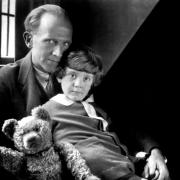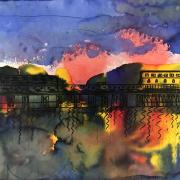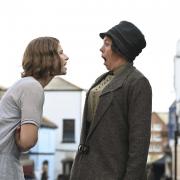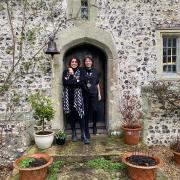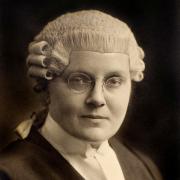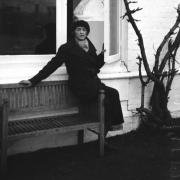Alfred, Lord Tennyson’s work is full of acute observations about the south-east of England

In November 1850 Victorian poet Alfred Tennyson was appointed to the honorary post of Poet Laureate. He would go on to hold the position for the next 42 years until his death in 1892, changing public perception of the role and giving it a new significance.
During this period Tennyson spent a good deal of time at Aldworth, his estate in West Sussex, so this seems the perfect opportunity to discover how the county’s landscape proved a source of inspiration, as well as celebrating the life of one of Britain’s greatest poets.
Alfred Tennyson was born in the small village of Somersby in Lincolnshire on 6 August 1809 where his father was the local vicar. He showed an aptitude for writing poetry from a young age.
Poems by Two Brothers, a collection of poems written by Alfred and his brother Charles, was published locally whilst Alfred was still a teenager. Further promise was shown when he was awarded the prestigious Chancellor’s Gold Medal for poetry during his time at Trinity College, Cambridge.

Tennyson’s first solo collection of poems, Poems Chiefly Lyrical, was published in 1830 and a second volume followed two years later. The 1832 collection included early versions of what would later become some of his best-loved works such as The Lady of Shalott, but upon release it was savaged by the critics.
With his confidence significantly dented, and faced with financial and health concerns, Tennyson did not publish any poetry for the next ten years.
He never stopped writing, however, and in 1842 he was finally persuaded by friends to publish a new collection, the two-volume Poems. The first volume included revised versions of previously published poems and the second volume consisted of entirely new work.
Tennyson was understandably nervous about how his poems would be received, but his fears proved unfounded. The collection was enthusiastically received and proved to be the platform for Tennyson’s future success.

With his literary career in the ascendancy, 1850 proved to be a seminal year in Tennyson’s life. He finally felt ready in June 1850 to marry his fiancée, Emily Sellwood, to whom he had been engaged on and off for ten years.
Whilst the couple took an extended honeymoon, one of Tennyson’s best-loved works, In Memoriam, was published. The poem was dedicated to Arthur Hallam, a fellow poet whom Tennyson had met during his time at Cambridge. Hallam had been tipped for literary greatness, but had died suddenly in 1833, aged just 22, after suffering a brain haemorrhage.
The two poets had formed a close friendship and Tennyson was much affected by Hallam’s death, often turning to poetry as a way of dealing with his sorrow and bewilderment at the loss. His work, In Memoriam, brought together for the first time these verses about bereavement including the often quoted line, “Tis better to have loved and lost than never to have loved at all”.
Bearing in mind Tennyson’s success in the role, it is perhaps surprising to discover that he was not initially the first choice for Poet Laureate upon the death of previous incumbent William Wordsworth in April 1770. He was considered to be too young and, instead, it was offered to the now little-known Samuel Rogers, who turned it down on account of his age.

More...Essential reads by Sussex authors
When Tennyson was appointed to the post, it was hoped that he would embrace the traditional requirements of the role to commemorate events of national significance. His predecessor, Wordsworth, had been ill for much of his time in the role and had produced virtually nothing. Tennyson didn’t disappoint.
His first act as Poet Laureate was to pen a dedicatory ode to Queen Victoria and within four years of his appointment he had produced two patriotic poems (Ode on the Death of the Duke of Wellington and The Charge of the Light Brigade), which tapped into the public mood perfectly.
In 1869 Tennyson and his wife Emily decided to build a house in Sussex. The county was already well known to the couple. For a few months in the autumn of 1852 the couple had rented a house in Seaford. Indeed, it is highly likely that the poet composed his tribute to the Duke of Wellington whilst living there.

From Seaford the couple had moved with their two young sons to live in Freshwater on the Isle of Wight, but by the late 1860s Tennyson was starting to tire of the constant public attention he received from visitors to the island and was looking to find a more peaceful haven to live and work during the summer months.
The location on which they decided for their new Sussex home was intentionally secluded and at that time accessible only by the most rudimentary of country lanes. It evidently appealed as much to the poet’s wife Emily as it did to himself. In an 1867 letter Tennyson remarks, “My wife has always had a fancy for the sandy soil and the heather-scented air of this part of England”.
Built on Black Down, the highest hill in the county, the grand Gothic-style house was designed by architect Sir James Knowles and completed in 1869. Tennyson himself had laid the first foundation stone on 23 April 1868, a significant date for the patriotic poet, being both St George’s Day and Shakespeare’s birthday.
The site on which the property was built comprised some 150 acres and had been originally known as Black Horse Copse. However, Tennyson named his new home Aldworth, in reference to a Berkshire village of the same name where Emily’s ancestors had lived.
The poet’s work is full of acute observations about nature and the Sussex countryside undoubtedly provided him with much inspiration in his later years. Most days he would walk about a mile from his home to The Temple of the Winds, which offered one of the best views of the South Downs in the whole area.
Another of the poet’s favourite destinations was a local beauty spot near the village of Grayswood, which is regarded as having been the inspiration for his 1886 poem The Brook.
Tennyson didn’t even need to leave his own property to appreciate the beauty of the area. The views from Aldworth over the Sussex Weald to the South Downs and the sea beyond were spectacular.
He famously described the scene in lines addressed to his friend Sir Edward Hamley,
“You came and looked and loved the view
Long known and loved by me,
Green Sussex fading into blue
With one grey glimpse of sea”
In 1883 the poet was given the title “Baron Tennyson of Aldworth in the County of Sussex and of Freshwater in the Isle of Wight”, becoming the first writer to receive such an honour. He is known to have declined a peerage twice previously and it has been suggested that he only finally accepted the title to secure his son Hallam’s future.
Towards the end of his life Tennyson wrote a poem called Crossing The Bar, which ends:
“For though from out our bourne of time and place
The flood may bear me far,
I hope to see my Pilot face to face,
When I have crossed the bar”
It was at Aldworth that he himself “crossed the bar” on 6 October 1892. His funeral was held in Westminster Abbey and he was laid to rest in Poets’ Corner.
Inspired by Tennyson, today’s visitors to this corner of Sussex still like to walk to the Temple of the Winds and rest awhile to enjoy the spectacular scenery. They may not be blessed with the creative genius of one of Britain’s best-loved poets, but it is not difficult to imagine how such views inspired the great man.
Join the conversation on our Facebook, Twitter and Instagram pages




